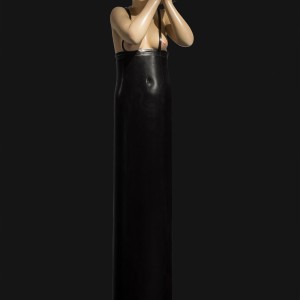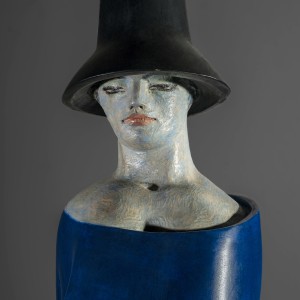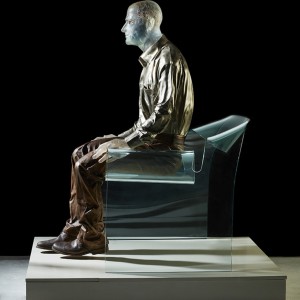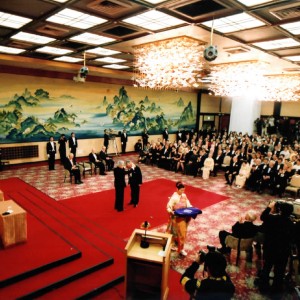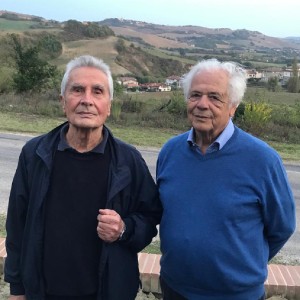In the exhibition dedicated to Leonardo and the Leonardeschi, 15 works from the 60s to today seal his link with classicism
Giuliano Vangi, who just passed away at the age of 93, admirably managed to combine the lessons of some great masters of the past with disturbing contemporary issues. When he came from Pesaro to the large studio in Pietrasanta, Versilia, he behaved as an inflexible, rigorous employee of himself: working hours from 8 a.m. to 12 p.m. and from 3 p.m. to 6 p.m. with a break for a frugal meal and to smoke a cigarette. The remaining time was to design, to define the idea of a sculpture to be modelled firstly in his mind because the electrocution or the slow growth of this idea had to follow the thread that linked that past to the awareness of the present and the projection in an image of amazement, to those who would have accepted the result of such a vision. In front of his compositions you could not and cannot remain impassive because they look at us, they question us in the depths of the soul and finally judge us. Let’s think for example of the work entitled Vejo that he made in 2010 using a motorcycle ridden by a figure cast in bronze whose terribility was highlighted by a double hand stretched out towards us and a grin partially covered by a mask. It was the sinister result of a misunderstanding of technological progress.
ORIGINALLY FROM BARBERINO DEL MUGELLO, SETTLED IN PESARO, HE HAD CHOSEN PIETRASANTA FOR HIS CREATIONS IN MARBLE WORKSHOPS AND FOUNDRIES
Vangi, a Tuscan from Barberino del Mugello, began sculpting at the age of seven using a stonemason and a mallet given to him by his grandfather to herald a rosy future that will also take him to Brazil for seven years where he will devote himself to abstraction. He will then make his transition to figuration according to a path that is at least singular compared to that normally undertaken by his colleagues. Settled in Pesaro, he will choose Pietrasanta for his experiments at the laboratories and foundries that have welcomed and realized creative and compositional proposals where color takes on a singular narrative value. In fact, Vangi also loved to provide an imprint, a true pictorial garment to sculpture through the contemporary use of different materials and color that justified: “The ancient Greeks loved to paint marbles. Unfortunately time has erased the traces of similar interventions.” Polychrome works in wood, marble, stone and bronze were created, where onyx, coral, ivory, nickel and silver provide intense or modulated expressive breaths. Among the first we remember in particular the sculpture Uomo in piedi in polychrome wood of 1963 belonged to Giovanni Testori, then the Donna con cappello nero dated 1989 with a wide emphasis in blue and the pensive Uomo vestito di grigio of 2000. Instead, the white Carrara marble is caressed by soft tonal variations in Elena, 1980 while a delicate chromatism, promoted by an alloy of nickel and silver, wraps Ragazza col cappotto, 1989. And he had also devised a unique system to concretely involve people in his creative intentions. Let’s think, for example, about Scultura della Memoria made for 150 years by Rossini, an intervention that includes homage to great personalities of the Marche as Raphael, the Duke of Montefeltro and Leopardi, and is surrounded by some benches. One of these is occupied by the silhouettes of a couple of lovers: “You can sit near them and be with them. It is an invitation to live the sculpture.”
LIKE THE ANCIENT GREEKS, HE ALSO LOVED TO PROVIDE TO SCULPTURE A PICTORIAL STYLE
This peculiarity of interpreting the world that belongs to us has been appreciated in the numerous exhibitions hosted in some of the main exhibition spaces in Europe, the United States and the Far East. We remember in particular the exhibition at the Società Promotrice delle Belle Arti in Turin in 1989 including 33 unpublished works and a group of drawings; in 1995 the exhibition at the Forte del Belvedere in Florence and the personal room at the Biennale di Venezia; in 2001 his solo exhibitions were held at the Hermitage in Saint Petersburg. The Open-Air Museum in Hakone, Japan, has purchased one of his artworks and the following year the Vangi Museum was opened in the city of Mishima, at the foot of Fujiyama, that houses a hundred sculptures and drawings. Later he received from the hands of Prince Hitachi the prestigious Imperial Prize considered the Nobel for Art. And, speaking of awards, at least the one of the President of the Republic received in 1983 should be mentioned; in 1995 he received the Donatello in Florence, in 1996 the Michelangelo in Rome and in 1998, again in Rome, the Feltrinelli Prize of the Accademia dei Lincei.
IN 2002, IN JAPAN HE RECEIVED FROM THE HANDS OF PRINCE HITACHI THE PRESTIGIOUS IMPERIAL PRIZE OF JAPAN CONSIDERED THE NOBEL FOR ART
On March 27th, the day after his departure, the The Palazzo Reale in Turin opened the exhibition “Autoritratto di Leonardo. Storia e contemporaneità di un capolavoro” (“Self-portrait of Leonardo. History and contemporaneity of a masterpiece”) where, together with the famous Autoritratto, the works of some Leonardesque painters appear. Contemporaneity is represented by fifteen artworks by Giuliano Vangi ranging from the 60s to today to seal his link with classicism. A timely posthumous tribute that emphasizes and honors the greatness and sensitivity of the artist who has just left us.



